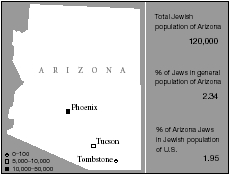Virtual Jewish World: Arizona, United States
Permanent settlement of Arizona by Europeans occurred after the California Gold Rush of 1848–50. The discovery of gold in Arizona brought many new residents to the state from 1862 to 1864. Most of them came from California, and they included many Jewish businessmen. During the 1860s much of the retail business in the towns of La Paz, Wickenburg, Prescott, and Tucson was operated by Jews. The merchants and entrepreneurs who set up enterprises at the sites of new mines also included Jews. When the mines were exhausted or proved unprofitable, businesses and entire communities were abandoned. Consequently, the business population and its Jewish component fluctuated sharply. The opportunities for mercantile activity brought to Arizona such pioneer Jewish families as Goldberg, Goldman, Solomon, Drachman, Zeckendorf, Steinfeld, Mansfeld, Isaacson, and Frank. Michael Goldwater (grandfather of Senator Barry Goldwater who was not of the Jewish faith) was a government contractor and freighter as well as a wholesale and retail merchant, a mine operator, and a forwarding agent. His son Morris served 22 years as mayor of Prescott. Charles and Harry Lesinsky opened large copper mines near Clifton in the mid-1870s, and to serve that enterprise they built Arizona's first railroad. Michael Wormser was Arizona's leading farmer at the end of the 19th century.
 Jewish communities in Arizona. Population figures for 2001. Jewish communities in Arizona. Population figures for 2001. |
Relations between Jews and Christians in pioneer Arizona were generally good; many well-known firms had Jewish and Christian partners. Only in rare instances did newspaper writers make disparaging remarks about Jews. Many Jews served in territorial and state legislatures. Jacob Weinberger was the youngest member of the state constitutional convention in 1910. Beginning in the 1880s, many easterners, especially those who suffered from tuberculosis, went to Arizona in hope of a cure. Some stayed on. During the mining boom in Tombstone (1881) the first organized Jewish community in the state emerged with Samuel Blace as president of the Jewish community. Newspapers reported Day of Atonement services that year, meeting in Turnverein Hall. A B'nai B'rith lodge was established in Tucson in 1882. From about the time of Arizona's statehood in 1912, an increasing number of Jews were in the professions, mainly law and medicine. The Jewish population grew rapidly after World War II. Houses of worship existed in Tucson, Phoenix, Mesa, and Scottsdale. Among the fields that Jews were most often found at the beginning of the 21st century were merchandising, the professions, technical fields, and service industries.
Among the leading Jewish officeholders of the state in the late 1960s were Justice Charles Bernstein of the State Supreme Court and Representative Sam Steiger of the third congressional district. Sam Coppersmith served in Congress in the 1980s. Andrew D Hurwitz and Stanley Feldman have served on the Arizona Supreme Court. There have been several Jewish mayors of Phoenix and Tucson in recent years.
Arizona had an estimated population in 2000 of 5,130,632, out of which 120,000 were Jews; of these 84,000 were in the Phoenix metropolitan area and 25,000 in Tucson . The Prescott Jewish community was estimated to be over 1,000. Organized Jewish congregations were also found in Flagstaff, Kingman, Lake Havasu, Sedona, and Yuma. In the latest demographic study (2002) Phoenix was ranked as the 13th largest Jewish community in the country and growing rapidly.
As of 2017, Arizona's Jewish population was approximately 106,725.
Sources: Encyclopaedia Judaica. © 2007 The Gale Group. All Rights Reserved. H. Parish, History of Arizona, 7 vols. (1915–18); F.S. Fierman, Some Early Jewish Settlers in the South Western Frontier (1960); idem, in: AJA, 16 (1964), 135–60; 18 (1966), 3–19; J.R. Marcus, ibid., 10 (1958), 95–120; Aron, ibid., 8 (1956), 94–98.



